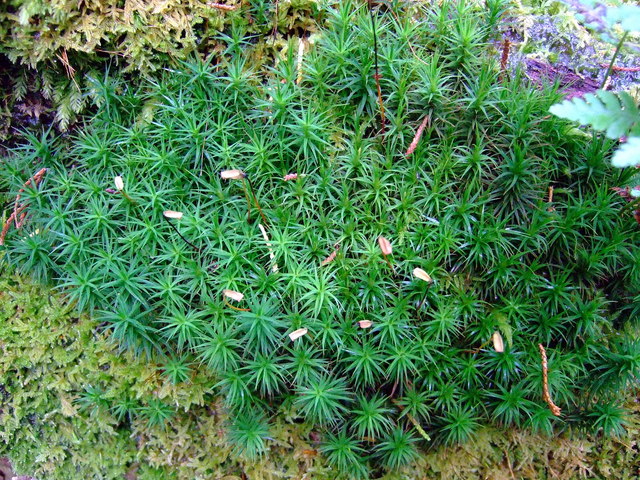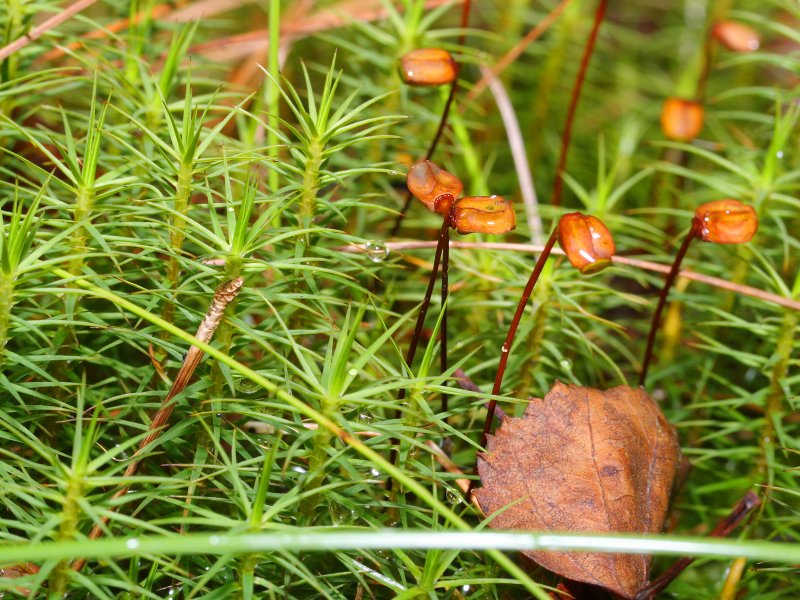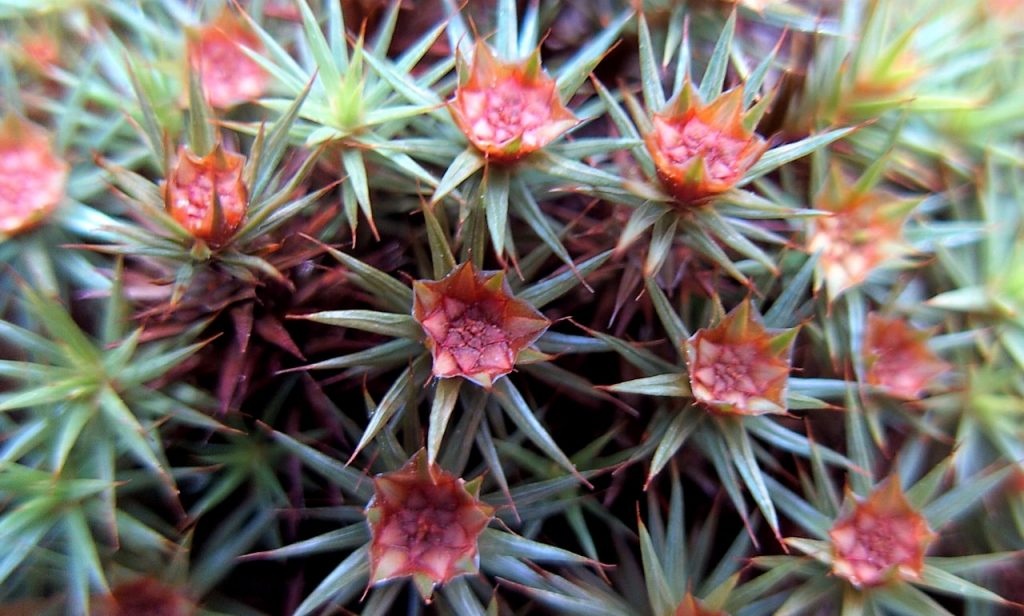Polytrichium: hairy cap moss

Polytrichium is a common moss that occurs across all of North America. It is large for a moss and regularly exhibits both the haploid and the diploid phases of its life cycle. Thus it is a useful example of what mosses are about. It is generally found in forests but can also be found on soil or gravel in open areas.
Phylogeny and taxonomy
In the past, the three groups of non-vascular plants (mosses, liverworts and hornworts) were put together in a taxonomic unit (Division Bryophyta = ‘Bryophytes’ = non-vascular plants), but there is little evidence that this is a unified group other than they are all plants. Mosses are distinct from the other two non-vascular groups and vascular plants are probably more closely related to liverworts than to mosses. Mosses are now generally put into their own division, the Bryophyta, distinct from the division of liverworts (Hepatophyta) and hornworts (Anthocerophyta). Within the Bryophyta there are around 12,000 species.

Structure
The gametophyte (haploid form) of mosses is the form that is usually seen. It is green, (photosynthetic) and lives for several years. Polytrichium has an erect unbranched stem with small pointed ‘leaves’ emerging off the sides. Technically it lacks ‘true’ vascular tissue because it lacks lignin. But it does produce cells, comparable to vascular cells, that are specialized for transport. Even without lignin for support Polytrichium can produce a stalk standing 4-10 cm tall. The plants have thread-like rhizoids emerging from the base of plant and attaching it to the substrate.
The gametophyte gets its name because it produces gametes. Polytrichium, but not all mosses, is dioecious, meaning that it has separate male and female plants. The gamete-producing organs appear at the tips of the stems, in structures (antheridia) that produce many mobile (flagellated) sperm on the male plants and structures (archegonia) on the female plants in which are produced a single, immobile egg.

The diploid form of the plant is called a sporophyte and it grows out of the structure that produces the egg (the archegonium). It has a typical spore-producing structure (cf. that of the cellular slime mold, Dictyostelium, or mushrooms) with a stalk (often over 5 cm) elevating a spore producing capsule at its top. The elevation provided by the stalk (seta) allows the spores to be more readily dispersed by the wind. Most moss capsules have one or two rings of teeth surrounding the opening of the capsule that can open and close, releasing spores under favorable (dry) conditions when they will be transported further by the wind.
Reproduction
Mosses exhibit the typical plant sexual life cycle that involves an ‘alternation of generations’, alternating between a haploid gametophyte and a diploid sporophyte, and the sexual cycle requires both. Unlike familiar animals who reproduce by directly making replicas of themselves, plants, including mosses like Polytrichium, alternate between two forms: the sporophyte makes gametophytes and the gametophytes make sporophytes. Note that, if one rigidly holds to a definition of organisms being entities distinct in space, then the sporophytes produced by gametophytes are not ‘new individuals’, just appendages off of old ones! The gametophyte of most mosses can reproduce asexually both growing in a clonal manner. Some mosses also can reproduce asexually by producing groups of cells (gemmae) that break off and can be dispersed, but these are not found in Polytrichium. In Polytrichum, only one sporophyte is produced for each female gametophyte. In some other mosses a single gametophyte may produce a several sporophytes but for all mosses it is the sporophyte generation does the bulk of the reproduction, producing many, many spores. Of even more significance, the production of spores is what allows the moss to spread to new areas, i.e. performs a dispersal function.
Matter and Energy
Hairy cap moss is a photosynthetic autotroph, it makes food (carbohydrate) through the process of photosynthesis and then uses this carbohydrate both as a material to make biomolecules and also to provide energy for metabolic activities. For the gametophyte, this is true throughout its existence. The sporophyte is usually only photosynthetic during its period of growth, if at all, and often loses its chlorophyll, and thus its ability to feed itself, as it matures, becoming dependent upon the gametophyte that it is growing out of for its food.
Mineral nutrition of mosses is different from that of vascular plants whose roots obtain nutrients from the soil solution. The rhizoids of mosses are limited in extent and lack the ability of transporting nutrients to the above ground portion because they specialized cells for transport. Most of the nutrients obtained by mosses probably comes through the leaves of the gametophytes that provide substantial surface area and, unlike the leaves of vascular plants, are generally not coated with a waterproof cuticle that retards absorption of water or dissolved solutes. The nutrients in the solution surrounding the leaves are provided by dust particles blown in the wind, solutes dissolved in precipitation and solutes added to precipitation as it flows down the trees and shrubs in the forest canopy (if there is one), as well as solutes that may be carried up with capillary water from the substrate that the moss is growing on. Sporophytes of mosses lack leaves and are not in contact with the soil and thus probably obtain all their nutrients from the gametophyte that they grow out of.
Interactions
Mosses are very common in a variety of habitats and are particular significant in some of them (e.g. Sphagnum moss in bogs). They are rarely eaten extensively and generally (with the significant exception of Sphagnum) produce very little biomass compared to vascular plants, thus their contribution to the trophic structure of most ecosystems is slight. However, they do provide habitat for a number of small invertebrates (see the article on tardigrades linked below), they can sequester nutrients, including carbon, and are often very important in soil formation on sites that previously have lacked a soil, i.e. in primary succession.
Further Reading
- Great book on mosses.
- Gathering Moss by Robin Wall Kimmerer ISBN 0879714993
- General information at Wikipedia.
- Bryophyte Ecology by Janice Glime. A tremendous source of information on moss ecology.
- “Tardigrades” by William Randolph Miller. An interesting article on tardigrades, fascinating tiny animals that often live in the environment surrounding moss leaves.
Media Attributions
- Common haircap moss (Polytrichum commune) © ceridwen is licensed under a CC BY-SA (Attribution ShareAlike) license
- Polytrichum commune © Kristian Peters is licensed under a CC BY-SA (Attribution ShareAlike) license
- Antheridia polytrichum © Ian Sutton is licensed under a CC BY (Attribution) license

